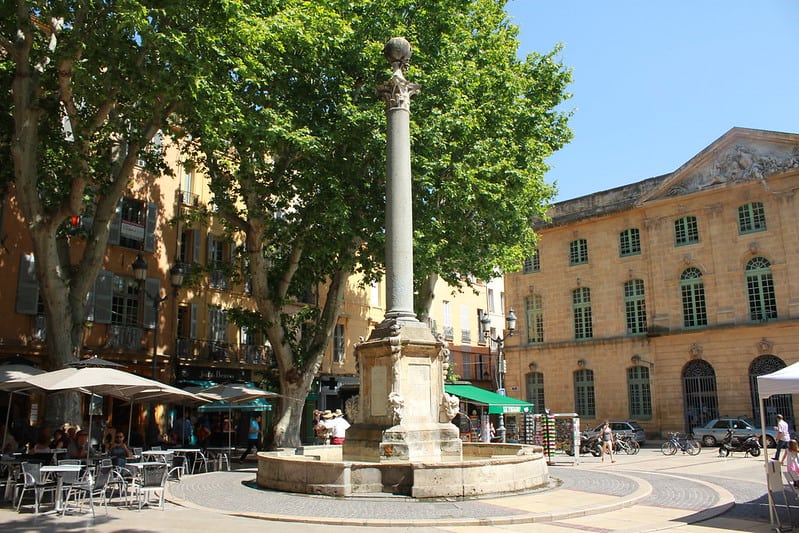Aix-en-Provence is a university city in southern France and the birthplace of French artist Paul Cézanne. Follow a walking trail linking Cézanne’s childhood home and former studio. Overlooking the city is the Sainte-Victoire mountain, which was the subject of many of Cézanne’s paintings. For those interested in art history, Aix-en-Provence has many art museums, including the Musee Granet and the Cathedrale St. Sauveur.
Cours Mirabeau
You can easily find your way around Aix-en-Provence by using the wide, leafy Cours Mirabeau. The main thoroughfare of the city, it is also known as the Avenue de la République. You will find plenty of shops and restaurants on the wide thoroughfare. For a more leisurely pace, you can even walk the length of the street. In fact, the city is so beautiful that you can even visit the ruins of the Roman theater.
You can take a stroll along the Cours Mirabeau, one of Europe’s most famous boulevards. It has an ambiance of Parisian Left Bank sophistication that seems eerily appropriate for Provence. You can enjoy a lively market along the sidewalks and wander the pedestrianized Old Town. A visit to this street will also introduce you to the city’s international student community.
Vieil Aix
Located in the south of France, Aix-en-Provence is a picturesque fortified town encapsulating the essence of southern France. Often called the ’21st arrondissement of Paris,’ Aix’s large boulevards and cobblestone alleys combine to make this a wealthy counterpoint to rough-edged Marseille. You can spend a day here and discover the city’s enchanting history and architecture.
There are numerous fountains throughout Aix, including the magnificent Fontaine du Roi Rene, one of the most popular in France. This fountain commemorates King Rene of Anjou, and is a 19th century masterpiece featuring bronze lions and statues of the Three Graces. The Fountain is not huge, but it is worth a visit. The city is also home to several sculptures, including the Fontaine du Roi Rene, which was sculpted by David d’Angers. The fountain is a beautiful piece of artwork, and the view from it is simply spectacular.
Aix is home to over a thousand fountains, including the famous Place d’Albertas. Walking around the Old Town, you can sample some local cuisine. For ice cream, you can try Amorino. Place d’Albertas is a picturesque square usually featured on city postcards. This was originally built by the Albertas family so they could perform theatrical shows in their courtyard.
Musee Granet
If you’re looking for a unique way to spend a day in Provence, the Musee Granet is a must-visit. Founded in 1854, it is home to an incredible collection of paintings and drawings by artists from all over the world. Picasso’s works, mostly of a romantic nature, are sure to impress. The museum has a large courtyard and an audio guide in English.
The Museum Granet in Aix-en-Provence has been recently renovated to showcase its permanent collections. It includes over 600 works of art and is organized by style, from the 17th to 20th century. Highlights of the collection include works by Picasso, Monet, and Matisse, as well as nine paintings by local artist Cezanne. Whether you’re looking for a modern view of the world or a historical perspective on the eras that shaped it, you can’t go wrong with the Musee Granet.
The museum is located in the historic Mazarin quarter of Aix-en-Provence. The permanent collection includes works by Rembrandt, Cezanne, Ingres, Giacometti, Picasso, and Mondrian. You can book a guided tour or take a special event to learn more about the works on display. This museum is a must-visit for art lovers.
Cathedrale St. Sauveur
The interior of Aix-en-Provence Cathedrale Saint-Sauveur is a marvel of artistic craftsmanship. The cathedral features a stone altarpiece that features six figures: St. Anne, Saint Louis, and St. Margaret. In the center is the Virgin holding the infant Jesus. St. Maurice is in 15th-century armour, and St. Margaret is rising from a dragon. The cathedral’s interior is comprised of three styles: Roman nef, gothic nef, and baroque nef. On the upper level is a cloitre adorned with huit columns.
The Aix-en-Provence Cathedrale Saint-Sauveur displays a stunning combination of styles. It was built over the site of an ancient Roman forum and temple to Apollo. The cathedral’s varied architecture is noteworthy, with Gothic and Romanesque gates, a bell tower, and octagonal font. The church is also surrounded by a courtyard with a beautiful olive tree.
Chateau La Coste en Provence
Aix-en-Provence is known as the city of a thousand fountains, and this university town boasts a beautiful location. In fact, this quaint city is the birthplace of world-renowned painter and draftsman, Paul Cezanne. He was born in the city in 1839, and was considered the father of twentieth century modernism. Whether you love the works of classical artists or contemporary art, this city is sure to impress.
Visit Chateau La Coste, a 17th century structure that’s more than a winery. Explore the art collection and architecture from a unique perspective, or take the art and architecture walk through the beautiful landscape. You’ll be wowed by the modern art and architecture pieces, and your trip to this picturesque city will be enriched as you learn more about the region’s history.
While you’re at Chateau La Coste, don’t forget to indulge in the cafe, which was designed by Japanese artist Tadao Ando. Enjoy a simple lunch, including Provencal cuisine, at this beautiful Chateau. You’ll also be able to sample wine produced by Chateau La Coste’s vineyard. Admission is just twenty euros, which includes a coffee or snack.
Fondation Vasarely
Located in Aix-en-Provence, the Fondation Vasarely was designed by architect Jean-Pierre Vasarely. The structure, which consists of sixteen hexagonal prisms, is divided into two floors and has various exhibition spaces. Inside, you can view several works by Vasarely, including a 133-seat auditorium, and enjoy a coffee in the cafeteria. Visitors can also take in some of the temporary exhibitions.
The controversy over the Vasarely family has long been in the news, but the recent case at the Fondation in Aix-en-Provence demonstrates how difficult it can be to manage a museum. The Vasarely family is highly complex, and the art in the Fondation is particularly sensitive. It is, therefore, important to follow up on any information you may have forgotten, and to do so as soon as possible.
The Fondation Vasarely in Aix-En-Provence contains a permanent exhibition and a full schedule of special events and educational programs. It is open Tuesday through Sunday from 10 a.m. to 1 p.m. and from 2 p.m. to 6 p.m. Admission is free, and there are discounts for groups, children, and the physically challenged.
Hotel de Caumont – Art Centre
The Hôtel de Caumont is a listed hôtel particulier in Aix-en-Provence. This property has been the center for contemporary art and design since the 1700s. The Hôtel de Caumont’s rooms have been refurbished and furnished with modern and contemporary designs. A cosy atmosphere is guaranteed in all rooms, which offer a variety of modern conveniences. A warm welcome is guaranteed by the staff at this Aix-en-Provence hotel.
The Hotel de Caumont is a beautiful private mansion in the heart of Aix-en-Provence, with an architecture that dates back to the 18th century. The Art Centre also hosts major temporary exhibitions and major art history masters. The art centre is a cultural landmark in Aix-en-Provence and is a must-visit for art lovers. Its gardens and courtyard create a serene and refined atmosphere. It is also a popular venue for weddings.
If you have time to visit this prestigious art centre, you should consider a stay at the Hotel de Caumont. It offers a wide selection of contemporary art and a beautiful gift shop. The hotel features a beautiful courtyard overlooking the gardens, a music room, and a tea room. The bright, light colors reflect the personality of Pauline de Caumont, who was the former lady of the house. The museum’s other rooms have been converted into exhibition venues for prestigious temporary exhibits.
Site Mémorial du Camp des Milles
The Camp des Milles is a French internment camp. It opened in September 1939 and was located in an old tile factory near the village of Les Milles, in the commune of Aix-en-Provence. The site was largely untouched during World War II, but has since been restored and now serves as a museum and memorial. This site is open to the public to learn about the experience of internment in this historic and poignant location.
The former tile factory became a concentration camp for political dissidents and other undesirables. More than 10,000 people were interned here. Many of these people had escaped persecution in the rest of France, but some were deported to concentration camps like Auschwitz. Of these, approximately 2,000 were Jewish. The Vichy regime turned the camp over to the Nazis, who then killed 10,000 people in the Unoccupied Zone. Artists such as Hans Bellmer and Max Ernst interned there. Their traces can be seen on the walls of the former tile factory.

